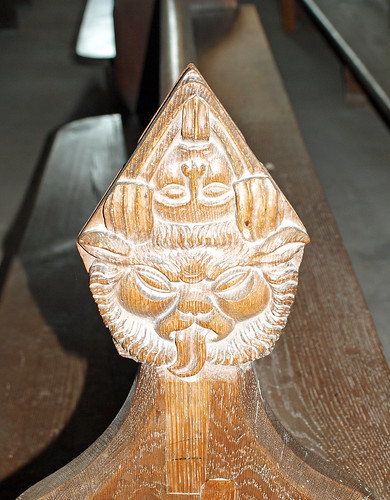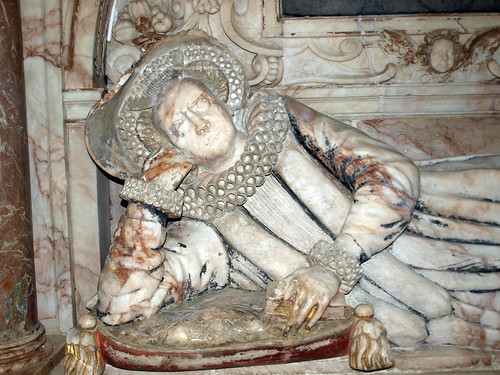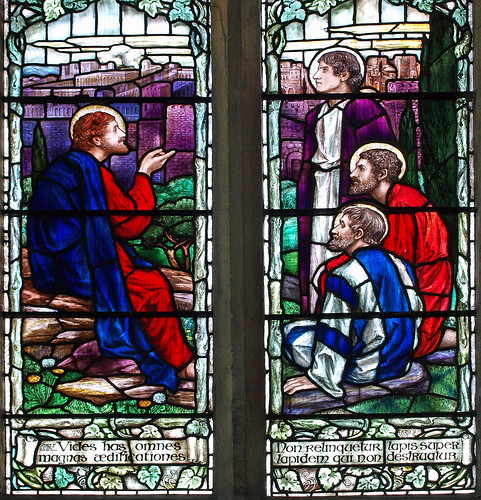ST ANDREW. The chancel comes first. Two E windows (their tracery C19), N and S windows with a variety of Y-tracery, SEDILIA and PISCINA, and chancel arch all point to the late C13 or c.r1300. Two S windows renewed. Dec with segmental arches. Dec also the aisle windows. Rood turret on the N side. The arcades (three bays) are Early Perp. The slender piers are typical, still with a square core and four demi-shafts, but Perp-looking capitals. Arches with sunk mouldings. Perp W tower. On the clasping buttresses concave-sided gables in relief. Tall two-light bell-openings with transom. Battlements. - FONT. Tall, octagonal, Perp, with shields, etc. - COMMANDMENT TABLES and ROYAL ARMS. Signed by John Everard of Stamford, 1790. Ionic pilasters with Gothic arches as frames. - STAINED GLASS. Much of c.1910. One pane is signed T.F. Curtis, Ward & Hughes 1910.* - BELLS. Two are medieval. They are assigned to Richard Hill (VCH). - PLATE. Cup and Cover Paten, 1619. - MONUMENTS. Bridget Lady Carre d. 1621. Semi-reclining on her side. Back arch with well-carved gristly cartouche. Columns l. and r. - Three good tablets (S aisle), dates 1689, 1705, 1790. That of 1705 is, according to Le Neve, by Edward Stanton. Excellent ornament and three cherubs’ heads at the top.
* But according to local tradition these windows were designed by Miss Erskine of Stamford.
UFFORD. On the way up its pleasant slope we pass an old barn with the record of a good deed on its gable end, the kindly bequest of a woman 200 years ago that the rent of this farm was to be given to six decayed gentlewomen for ever. At the top of the hill the church and the rectory make a delightful group.
Most of the church is 600 years old, and in the rectory is a fine medieval timber roof believed to have come from a manor house which vanished long ago. The church has work from the three medieval centuries, its battlemented tower being 15th century; it has eight gargoyles. The porch through which we enter is also 15th. The scratch dial on the south wall is probably older, having told the people the time of mass in the days before clocks. The tower arch inside has fierce heads of lions looking into the nave; the nave itself has 14th century arcades with grotesque heads and the original timber roof. which extends also over both aisles. The lofty chancel arch has still on each side arches which led to the roodloft, and in the north aisle are two stone seats for priests. Both aisles have a piscina, and in the chancel is a much-worn sedilia of the 13th century. Six chancel windows have richly coloured figures in vivid New Testament scenes, all 20th century, and there is a little medieval glass in the windows of the north aisle.
Set along the north aisle wall are ancient wooden benches with quaint medieval ends, huge poppyheads with a variety of human faces ringed in crude foliage; some of the faces have their tongues out. All the modern benches are modelled on these old seats. The 15th century font is remarkable for its height (four feet six), and part of its base is fashioned as a stone step for the priest. Below the octagonal bowl is a band of Tudor flowers and grotesque heads. The font cover, also 15th century, rises cone-like with carved ribs to a finial of two small figures standing back to back. On the bowl is the hook and staple by which the font was locked against witches.
On a board between two 14th century windows in the north aisle is an elaborate setting for the Commandments, which are in Gothic arches resting on pilasters, angels holding up curtains on each side. The artist was evidently proud of his work, for he put his name on the bases of the pilasters, Everard Stamford, painter, 1799. In the wide chancel is a handsome monument on which lies a great lady of fashion who was gentlewoman to Queen Elizabeth for 25 years and to James the First’s queen for 14 years more. She is a charming figure in marble, decked out with crimped double ruffs at neck and wrists, with a wide farthingale and elaborately dressed hair.
Most of the church is 600 years old, and in the rectory is a fine medieval timber roof believed to have come from a manor house which vanished long ago. The church has work from the three medieval centuries, its battlemented tower being 15th century; it has eight gargoyles. The porch through which we enter is also 15th. The scratch dial on the south wall is probably older, having told the people the time of mass in the days before clocks. The tower arch inside has fierce heads of lions looking into the nave; the nave itself has 14th century arcades with grotesque heads and the original timber roof. which extends also over both aisles. The lofty chancel arch has still on each side arches which led to the roodloft, and in the north aisle are two stone seats for priests. Both aisles have a piscina, and in the chancel is a much-worn sedilia of the 13th century. Six chancel windows have richly coloured figures in vivid New Testament scenes, all 20th century, and there is a little medieval glass in the windows of the north aisle.
Set along the north aisle wall are ancient wooden benches with quaint medieval ends, huge poppyheads with a variety of human faces ringed in crude foliage; some of the faces have their tongues out. All the modern benches are modelled on these old seats. The 15th century font is remarkable for its height (four feet six), and part of its base is fashioned as a stone step for the priest. Below the octagonal bowl is a band of Tudor flowers and grotesque heads. The font cover, also 15th century, rises cone-like with carved ribs to a finial of two small figures standing back to back. On the bowl is the hook and staple by which the font was locked against witches.
On a board between two 14th century windows in the north aisle is an elaborate setting for the Commandments, which are in Gothic arches resting on pilasters, angels holding up curtains on each side. The artist was evidently proud of his work, for he put his name on the bases of the pilasters, Everard Stamford, painter, 1799. In the wide chancel is a handsome monument on which lies a great lady of fashion who was gentlewoman to Queen Elizabeth for 25 years and to James the First’s queen for 14 years more. She is a charming figure in marble, decked out with crimped double ruffs at neck and wrists, with a wide farthingale and elaborately dressed hair.



No comments:
Post a Comment